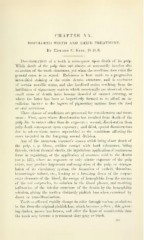Page 537 - My FlipBook
P. 537
CHAPTER XX.
DISCOLORED TEETH AND THEIR TREATMENT.
By Edavaed C. Kirk, D. D. S.
Discoloration of a tooth is consequent upon death of its pulp.
"While death of the pulp does not always or necessarily involve dis-
coloration of the tooth structures, yet ^\\\en the condition does exist the
general cause is as stated. Reference is here nuule to a progressive
interstitial staining of the entire dentin structure, and is exclusive
of certain metallic stains, and also localized stains resulting from the
imbibition of pigmentary matters which occasionally are observed where
small areas of dentin have become denuded of enamel covering, or
where the latter has been so imperfectly formed as to afford an in-
sufficient barrier to the ingress of pigmentary matters from the food
or oral secretions.
Three classes of conditions are presented for consideration and treat-
ment : First, cases where discoloration has resulted from death of the
pulp due to causes other than its exposure ; second, discoloration from
])ulp death consequent upon exposure ; and third, special discolorations
due to adventitious causes superadded to the conditions affecting the
cases included in the foregoing second division.
Any of the numerous traumatic causes which bring about death of
the pulp, e. g. blows, sudden contact with hard substances, biting
threads, violent thermal shocks, the injudicious application of continuous
force in regulating, or the application of arsenous oxid to the dentin
(see p. 425), where no exposure or only minute exposure of the pulp
exists, may produce hyperemia and congestion of the pulp, or strangu-
lation of its circulatory system, the formation of emboli, thrombus,
hemorrhagic infarct, etc., leading to a breaking down of the corpus-
cular elements of the blood, the escape of hemoglobin from the stroma
of the red corpuscles, its solution in the blood plasma, and resulting
infiltration of the tubular structure of the dentin by the hemoglobin
solution, giving the tooth a distinctly pinkish hue when examined by
direct or transillumination.
Teeth so affected rapidly change in color through various gradations
in tint from the original pinkish hue, which becomes yellow^ ; this, grow-
ing darker, passes into brown, and after the lapse of considerable time
the tooth may become a permanent slaty gray or black.
535


